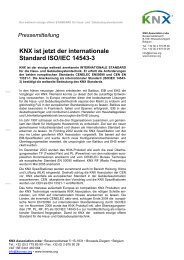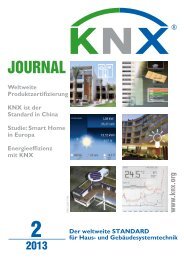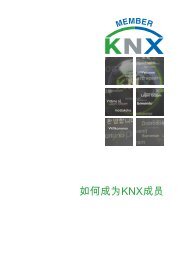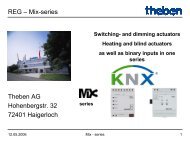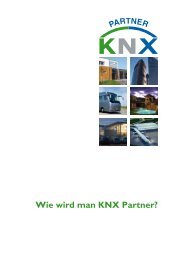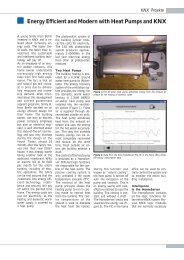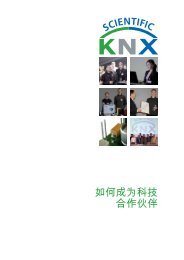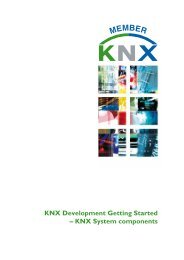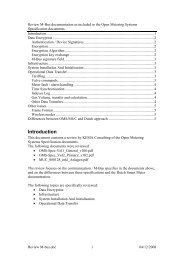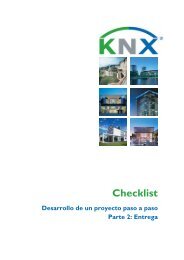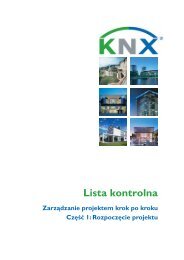KNX Communication
KNX Communication
KNX Communication
You also want an ePaper? Increase the reach of your titles
YUMPU automatically turns print PDFs into web optimized ePapers that Google loves.
<strong>KNX</strong> <strong>Communication</strong><br />
<strong>KNX</strong> Association
<strong>KNX</strong> BASIC COURSE<br />
Table of Contents<br />
1 Basic Method of Operation .........................................................................................3<br />
2 Individual address ...................................................... Error! Bookmark not defined.<br />
3 Group Address ...........................................................................................................6<br />
4 Group object .............................................................. Error! Bookmark not defined.<br />
4.1 Flags ..................................................................................................................9<br />
5 Useful Data of a TP1 telegram ................................................................................. 10<br />
6 Standardized Datapoint Types (DPT) ....................................................................... 11<br />
6.1 Switch (1.001) .................................................................................................. 12<br />
6.2 Functional block Shutter Control....................................................................... 13<br />
6.3 Switch Control (2.001)...................................................................................... 14<br />
6.4 Functional Block “Dimming”.............................................................................. 15<br />
6.5 2 Octet Float Value (9.00x)............................................................................... 17<br />
7 TP1 Bit Structure ...................................................................................................... 18<br />
8 TP1 Telegram Collision ............................................................................................ 19<br />
9 TP1 Symmetrical Transmission ................................................................................ 20<br />
10 Superimposing Data and Supply Voltage ................................................................. 21<br />
11 Connection of the Power Supply Unit to the TP1 Bus .............................................. 22<br />
12 TP1 Cable Lengths .................................................................................................. 23<br />
12.1 Cable Length between TP1 Power Supply Unit and TP1 Bus Device ............... 24<br />
12.2 Cable Lengths between two TP 1 Bus Devices ................................................ 25<br />
12.3 Total Cable Length per TP 1 Line Segment ..................................................... 25<br />
Home and Building Management Systems<br />
<strong>KNX</strong> Association<br />
<strong>KNX</strong> <strong>Communication</strong> <strong>Communication</strong>_E1212a 2/25
<strong>KNX</strong> BASIC COURSE<br />
Definition<br />
The following terms are used as synonyms in <strong>KNX</strong> literature:<br />
Physical address and individual address<br />
<strong>Communication</strong> object and group object<br />
The terms individual address and group objects are commonly used In the <strong>KNX</strong><br />
training documentation as well as in ETS.<br />
1 Basic Method of Operation<br />
Figure 1: Basic method of operation<br />
A minimum TP1 <strong>KNX</strong> installation consists of the following components:<br />
a power supply unit (DC 30 V)<br />
a choke (can also be integrated in the power supply unit)<br />
sensors (a single switch sensor is represented in the figure above)<br />
actuators (a single switch actuator is represented in the figure above)<br />
bus cable (only two wires of the bus cable are required).<br />
After the installation and in the case of S-mode compatible products, a <strong>KNX</strong> system is not<br />
ready for operation until sensors and actuators have been loaded with application<br />
Home and Building Management Systems<br />
<strong>KNX</strong> Association<br />
<strong>KNX</strong> <strong>Communication</strong> <strong>Communication</strong>_E1212a 3/25
<strong>KNX</strong> BASIC COURSE<br />
software with the help of the ETS program. The project engineer must first have carried<br />
out the following configuration steps using ETS:<br />
assignment of individual addresses to the different devices (for the unique<br />
identification of a sensor or actuator in a <strong>KNX</strong> installation);<br />
selection and setting (parameterisation) of the appropriate application software for<br />
sensors and actuators;<br />
assignment of group addresses (for linking the functions of sensors and actuators).<br />
In the case of E-mode compatible products, the same steps as above have to be applied,<br />
whereby:<br />
the individual addresses<br />
parameterisation of the appropriate application software for sensors and actuators<br />
and;<br />
the assignment of group addresses (for linking the functions of sensors and actuators)<br />
is done via either local settings or automatically by a central controller.<br />
After the above configuration, the installation could function as follows:<br />
If the upper rocker of the single switch sensor (1.1.1) is pressed, it sends a telegram<br />
which contains the group address (5/2/66) and the value (“1”) as well as<br />
miscellaneous data.<br />
This telegram is received and evaluated by all connected sensors and actuators.<br />
Only the devices with the same group address:<br />
• send an acknowledgement telegram<br />
• read the value and behave accordingly. In our example, the switch actuator (1.1.2)<br />
will close its output relay.<br />
When the lower rocker is pressed, the same process occurs except that the value is set<br />
to “0” this time and the output relay of the actuator is thereby opened.<br />
The respective elements of the <strong>KNX</strong> system are explained in more detail on the following<br />
pages.<br />
Home and Building Management Systems<br />
<strong>KNX</strong> Association<br />
<strong>KNX</strong> <strong>Communication</strong> <strong>Communication</strong>_E1212a 4/25
<strong>KNX</strong> BASIC COURSE<br />
2 Individual address<br />
Figure 2: Individual address<br />
An individual address must be unique within a <strong>KNX</strong> installation. The individual address is<br />
configured as described above. It has the following format: Area [4 bit] - Line [4 bit] – Bus<br />
device [1 byte]. The bus device is normally prepared for the acceptance of its individual<br />
address by pressing a programming button on the bus device. The programming LED is<br />
lit during this process. The individual address is also used for the following purposes after<br />
the commissioning stage:<br />
Diagnosis, error rectification, modification of the installation by reprogramming<br />
Addressing of the interface objects using commissioning tools or other devices.<br />
Important: The individual address has no significance during normal operation of<br />
the installation.<br />
Home and Building Management Systems<br />
<strong>KNX</strong> Association<br />
<strong>KNX</strong> <strong>Communication</strong> <strong>Communication</strong>_E1212a 5/25
<strong>KNX</strong> BASIC COURSE<br />
3 Group Address<br />
Figure 3: Group Address<br />
<strong>Communication</strong> between devices in an installation is carried out via group addresses.<br />
When setting the group address via ETS, it can be selected as a “2-level” (main group/<br />
subgroup), “3-level” structure (main group/middle group/subgroup) or a freely defined<br />
structure. The level structure can be changed in the project properties of each individual<br />
project.. The group address 0/0/0 is reserved for so-called broadcast messages<br />
(telegrams to all available bus devices).<br />
The ETS project engineer can decide how the levels will be used e.g. as in the following<br />
pattern:<br />
Main group = floor<br />
Middle group = functional domain (e.g. switching, dimming)<br />
Subgroup = function of load or group of loads (e.g. kitchen light on/off, bedroom<br />
window on/off, ceiling living room on/off, ceiling living room dimming,…).<br />
One should stick to the selected pattern of group addresses in all projects.<br />
Each group address can be assigned to the bus devices as required, regardless of where<br />
the device is installed in the system.<br />
Home and Building Management Systems<br />
<strong>KNX</strong> Association<br />
<strong>KNX</strong> <strong>Communication</strong> <strong>Communication</strong>_E1212a 6/25
<strong>KNX</strong> BASIC COURSE<br />
Actuators can listen to several group addresses. Sensors however can only send one<br />
group address per telegram.<br />
The group addresses are assigned to the group objects of the respective sensors and<br />
actuators, either by creating and assigning them with the help of ETS (S-mode) or<br />
automatically and invisible to the user in E-mode.<br />
Note:<br />
When using the main groups 14 resp. 15 or higher in ETS, you should take into<br />
account that these group addresses are not filtered by TP1 couplers and could<br />
therefore negatively influence the dynamics of the entire bus system.<br />
The number of group addresses that can be attributed to a sensor or actuator is<br />
variable and depends on the size of the memory.<br />
Home and Building Management Systems<br />
<strong>KNX</strong> Association<br />
<strong>KNX</strong> <strong>Communication</strong> <strong>Communication</strong>_E1212a 7/25
<strong>KNX</strong> BASIC COURSE<br />
4 Group object<br />
Figure 4: Group object<br />
<strong>KNX</strong> group objects are memory locations in bus devices. The size of these objects can be<br />
between 1 bit and 14 bytes. The size of the group objects is dependent on its function.<br />
As only two states (0 and 1) are required for switching, 1 bit group objects are used. The<br />
data involved in text transmission is more comprehensive and therefore group objects<br />
with a maximum size of 14 bytes are used.<br />
The ETS only allows to link objects with the same size using group addresses. Several<br />
group addresses can be assigned to one group object, but only one is the sending group<br />
address.<br />
An object value is sent on the bus in the following way:<br />
a) If the upper left rocker is pressed for example, the two-fold switch sensor writes a “1”<br />
to its group object with the number 0. As the communication and transmit flag are set<br />
for this object, this device will send a telegram on the bus with the information “Group<br />
address 1/1/1, write value, 1”.<br />
b) All the bus devices throughout the <strong>KNX</strong> installation that also have the group address<br />
1/1/1 will then write “1” in their own group object.<br />
c) In our example, the “1” is written in group object no. 0 of the actuator.<br />
d) The application software of the actuator establishes that the value in this group object<br />
has changed and executes the switching process.<br />
Home and Building Management Systems<br />
<strong>KNX</strong> Association<br />
<strong>KNX</strong> <strong>Communication</strong> <strong>Communication</strong>_E1212a 8/25
<strong>KNX</strong> BASIC COURSE<br />
4.1 Flags<br />
Each group object has flags which are used to set the following properties:<br />
<strong>Communication</strong> The group object has a normal link to the bus.<br />
<br />
Telegrams are acknowledged. The group object is not modified.<br />
READ The object value can be read via the bus.<br />
<br />
The object value CANNOT be read via the bus.<br />
WRITE The object value can be modified via the bus.<br />
<br />
The object value CANNOT be modified via the bus.<br />
TRANSMIT A telegram is transmitted when the object value (at the sensor) has been<br />
modified.<br />
<br />
The group object will generate a response only when receiving a read request.<br />
UPDATE Value response telegrams are interpreted as a write command. The value of<br />
the group object is updated (always enabled in System 1 devices)<br />
<br />
Value response telegrams are NOT interpreted as a write command. The<br />
value of the group object remains unchanged.<br />
READ ON INIT The device independently sends Read value commands for the initialisation of<br />
the group object after return of current (only available on certain masks)<br />
<br />
After return of current the device does not initialise the value of the assigned<br />
group object via Read Value commands<br />
Please note: The default flags should only be changed in exceptional circumstances.<br />
For further information you can consult the topic “Flags” in the chapter “Project Design” of<br />
the basic course documentation or the chapter “Flags” in the advanced course<br />
documentation.<br />
Home and Building Management Systems<br />
<strong>KNX</strong> Association<br />
<strong>KNX</strong> <strong>Communication</strong> <strong>Communication</strong>_E1212a 9/25
<strong>KNX</strong> BASIC COURSE<br />
Figure 5: Useful data of TP1 telegram<br />
5 Useful Data of a TP1 telegram<br />
The actual payload determines the type of command. The actual payload is explained in<br />
the above figure using the example of a 1-bit telegram. In the case of the “write”<br />
command the last bit on the right contains a “1” or a “0” for “Switch on” or “Switch off”.<br />
A “read” command requests the addressed group object to report its status. The reply<br />
may be a 1-bit message as in the example of the “write” command, or it can use up to 13<br />
bytes (bytes 2 to 15).<br />
The length of the data is dependent on the datapoint type used.<br />
Home and Building Management Systems<br />
<strong>KNX</strong> Association<br />
<strong>KNX</strong> <strong>Communication</strong> <strong>Communication</strong>_E1212a 10/25
<strong>KNX</strong> BASIC COURSE<br />
Figure 6: Standardized Datapoint types<br />
6 Standardized Datapoint Types (DPT)<br />
Datapoint types were standardised to guarantee the compatibility of similar devices from<br />
different manufacturers (e.g. dimmers, clock).<br />
The standardisation includes requirements on the data format and structure of the group<br />
objects as well as for sensor and actuator functions. The combination of several<br />
standardised datapoint types (e.g. in dimming actuators) is called a functional block.<br />
The designation of a datapoint type is geared towards the application for which it was<br />
conceived. This does not always imply that the use of the DPT is limited to this area of<br />
application. For example “Scaling” (Type 5.001) can also be used both for setting a<br />
dimming brightness or for setting a heating valve position.<br />
A selection of frequently used datapoint types is given on the following pages. The full list<br />
of standardised datapoint types can be downloaded from the <strong>KNX</strong> web site<br />
(www.knx.org).<br />
Home and Building Management Systems<br />
<strong>KNX</strong> Association<br />
<strong>KNX</strong> <strong>Communication</strong> <strong>Communication</strong>_E1212a 11/25
<strong>KNX</strong> BASIC COURSE<br />
Figure 7: DPT Switch (1.001)<br />
6.1 Switch (1.001) 1<br />
The switch function is used for switching an actuator function. Other one bit datapoint<br />
types are defined for logical operations (Boolean [1.002]), Enable [1.003]), etc...).<br />
Other functions or extensions to the pure switching function (inversion, time delay and<br />
toggle switch functions) are not part of the DPT description but parameters of the<br />
functional block specification, in which this DPT is used (e.g. functional block light switch).<br />
1 previously referred to as EIS1<br />
Home and Building Management Systems<br />
<strong>KNX</strong> Association<br />
<strong>KNX</strong> <strong>Communication</strong> <strong>Communication</strong>_E1212a 12/25
<strong>KNX</strong> BASIC COURSE<br />
Figure 8: Functional block Shutter Control<br />
6.2 Functional block Shutter Control 2<br />
The functional block “Shutter control” is principally used for the control of shutter and blind<br />
drive mechanisms and provides at least the following datapoint types as group objects<br />
Up/Down (1.008)<br />
Step (1.007).<br />
By writing on the Up/Down, a drive is set in motion from an idle state or changes direction<br />
while moving.<br />
By writing on the Step, a drive which is already in motion is brought to a stop or a halted<br />
drive is set in motion for short periods (step-by-step).<br />
Important: Group objects which use this function should never reply to read requests via<br />
the bus as they may unintentionally stop moving drives or set halted drives in motion. The<br />
“read” flag should therefore be deactivated in the relevant group objects – both in sensors<br />
as well as actuators. This especially applies for central functions.<br />
2 previously referred to as EIS7<br />
Home and Building Management Systems<br />
<strong>KNX</strong> Association<br />
<strong>KNX</strong> <strong>Communication</strong> <strong>Communication</strong>_E1212a 13/25
<strong>KNX</strong> BASIC COURSE<br />
Figure 9: Switch Control (2.001)<br />
6.3 Switch Control (2.001) 3<br />
The Switch Control is used to operate actuators – next to the normal operation via the<br />
Switch – by a group object with higher priority.<br />
The switching function of a connected device depends on the state of the two group<br />
objects Switch and Switch Control.<br />
The group object of type Switch Control has a size of 2 bits.<br />
If the value of the 2 bit object is 0 or 1, the connected actuator is controlled via the<br />
switching object.<br />
If the value of the priority object is 2, the output is switched off respectively on when the<br />
value is 3. The value of the switching object is in both cases ignored.<br />
3 Previously referred to as EIS 8<br />
Home and Building Management Systems<br />
<strong>KNX</strong> Association<br />
<strong>KNX</strong> <strong>Communication</strong> <strong>Communication</strong>_E1212a 14/25
<strong>KNX</strong> BASIC COURSE<br />
Figure 10: Functional Block "Dimming"<br />
6.4 Functional Block “Dimming” 4<br />
Apart from the 4 bit object (Dim Step – 3.007), the functional block dimming consists of at<br />
least a switching object (corresponds to Switch) and a value object (corresponds to<br />
Scaling – 5.001).<br />
A dimming command, relative to the current brightness setting, is transmitted to the<br />
dimming actuator using the Dim Step.<br />
Bit 3 of the useful data determines whether the addressed device dims down or up<br />
compared to the current brightness value.<br />
Bits 0 to 2 determine the dimming range. The area of brightness (0-100%) is divided into<br />
64 dimming levels. The dimming actuator always dims to the next dimming level. For<br />
example: a dimming actuator has a brightness level of 30%. If a sensor sends 1011 B as<br />
useful data, a dimming brighter command is carried out until the next dimming threshold<br />
is reached (or 100% divided by 4 = 25%, i.e. the next level is 50%).<br />
The dimming code 0 (i.e. useful data 00 HEX or 80 HEX ) means “Stop Dimming”. The<br />
dimming process is interrupted and the current brightness value is retained.<br />
4 previously referred to as EIS 2<br />
Home and Building Management Systems<br />
<strong>KNX</strong> Association<br />
<strong>KNX</strong> <strong>Communication</strong> <strong>Communication</strong>_E1212a 15/25
<strong>KNX</strong> BASIC COURSE<br />
Figure 11: Value object<br />
With the Scaling, a brightness value between 1 (minimum) and 255 (maximum) is set<br />
directly.<br />
Depending on the manufacturer‘s application, it may be possible to switch on (1 ≤ value ≤<br />
255) or off (value = 0) a connected device using this DPT.<br />
The DPT has a size of 1 byte.<br />
Home and Building Management Systems<br />
<strong>KNX</strong> Association<br />
<strong>KNX</strong> <strong>Communication</strong> <strong>Communication</strong>_E1212a 16/25
<strong>KNX</strong> BASIC COURSE<br />
Figure 12: 2 octet Float Value<br />
6.5 2 Octet Float Value (9.00x) 5<br />
With this data format (which has a number of different datapoint types according to the<br />
nature of the sent value, e.g. room temperature °C – 9.001), numbers which represent<br />
physical values can be transmitted.<br />
“S” is the sign for the mantissa.<br />
The four-digit exponent “E” is an integer exponent to the base of 2.<br />
A resolution of 0.01 is defined for the mantissa “M”. Positive values (“S” = 0) take the form<br />
of normal binary numbers. Negative values (“S” = 1) are coded by the mantissa as two‘s<br />
complement numbers.<br />
The size of the DPT is 2 bytes.<br />
5 previously referred to as EIS 5<br />
Home and Building Management Systems<br />
<strong>KNX</strong> Association<br />
<strong>KNX</strong> <strong>Communication</strong> <strong>Communication</strong>_E1212a 17/25
<strong>KNX</strong> BASIC COURSE<br />
Figure 13: TP1 bit structure<br />
7 TP1 Bit Structure<br />
“0” and “1” are the two logical states a bit can possess.<br />
Technical logic in <strong>KNX</strong> TP1:<br />
During logical state “1”, no signal voltage is available<br />
During logical state “0”, signal voltage is available<br />
If several bus devices transmit simultaneously, the logical state “0” prevails!<br />
Home and Building Management Systems<br />
<strong>KNX</strong> Association<br />
<strong>KNX</strong> <strong>Communication</strong> <strong>Communication</strong>_E1212a 18/25
<strong>KNX</strong> BASIC COURSE<br />
Figure 14: TP1 Telegram Collision<br />
8 TP1 Telegram Collision<br />
A bus device with data to transmit may start transmission immediately if it finds the bus<br />
unoccupied.<br />
The simultaneous sending request of several bus devices is controlled by the CSMA/CA<br />
procedure (Carrier Sense Multiple Access with Collision Avoidance).<br />
The bus devices listen to the bus while transmitting. As soon as a bus device with the<br />
logical state “1” detects the logical state “0” (= flow of current on the line), it stops<br />
transmitting to give way to the other sending device.<br />
The bus device that terminated its transmission continues to listen to the network to await<br />
the end of the telegram transmission and then retries its transmission.<br />
In this way, if several bus devices are attempting to transmit simultaneously, the<br />
CSMA/CA procedure ensures that only one of these bus devices can terminate its<br />
transmission uninterruptedly. The data throughput is therefore not reduced.<br />
Home and Building Management Systems<br />
<strong>KNX</strong> Association<br />
<strong>KNX</strong> <strong>Communication</strong> <strong>Communication</strong>_E1212a 19/25
<strong>KNX</strong> BASIC COURSE<br />
Figure 15: TP1 Symmetrical Transmission<br />
9 TP1 Symmetrical Transmission<br />
The data is transmitted symmetrically over the pair of cores. Bus devices evaluate the<br />
difference in voltage between the two cores.<br />
As radiated noise affects both cores with the same polarity, it has no influence on the<br />
difference in the signal voltage.<br />
Home and Building Management Systems<br />
<strong>KNX</strong> Association<br />
<strong>KNX</strong> <strong>Communication</strong> <strong>Communication</strong>_E1212a 20/25
<strong>KNX</strong> BASIC COURSE<br />
Figure 16: Superimposing Data and Supply Voltage<br />
10 Superimposing Data and Supply Voltage<br />
Data is transmitted in the form of a.c. voltage. The capacitor reacts with a low resistance<br />
to a.c. voltage, i.e. it acts as a conductor and closes the circuit on the primary side. When<br />
acting as a transmitter, the transformer sends the data to the primary side (in the form of<br />
a.c. voltage) where it is superimposed onto the d.c. voltage.<br />
When acting as a receiver, the transformer sends the data to the secondary side where it<br />
is separately available from the d.c. voltage.<br />
Home and Building Management Systems<br />
<strong>KNX</strong> Association<br />
<strong>KNX</strong> <strong>Communication</strong> <strong>Communication</strong>_E1212a 21/25
<strong>KNX</strong> BASIC COURSE<br />
Figure 17: Connection of Power supply to TP1 bus<br />
11 Connection of the Power Supply Unit to the TP1 Bus<br />
The power is supplied to the installation bus via a choke.<br />
When d.c. voltage is supplied, the choke reacts with low resistance (as the frequency is<br />
equal to 0 Hz).The data is transmitted in the form of a.c. voltage (frequency is not equal<br />
to 0). The choke reacts with high resistance to a.c. voltage.<br />
Hence the power supply unit’s influence on the data is negligible.<br />
Home and Building Management Systems<br />
<strong>KNX</strong> Association<br />
<strong>KNX</strong> <strong>Communication</strong> <strong>Communication</strong>_E1212a 22/25
<strong>KNX</strong> BASIC COURSE<br />
Figure 18: TP1 Cable lengths<br />
12 TP1 Cable Lengths<br />
Within a bus line, the following cable lengths are permitted:<br />
Power Supply Unit - Bus device ................................................................... max. 350 m<br />
Bus device - Bus device ............................................................................... max. 700 m<br />
Total bus line length ................................................................................... max. 1000 m<br />
Distance between 2 power supply units in one line…As specified by the manufacturer<br />
When using a decentralised power supply, please check the chapter ‘installation’.<br />
Home and Building Management Systems<br />
<strong>KNX</strong> Association<br />
<strong>KNX</strong> <strong>Communication</strong> <strong>Communication</strong>_E1212a 23/25
<strong>KNX</strong> BASIC COURSE<br />
Figure 19: Cable Length between TP1 power supply unit and TP1 bus device<br />
12.1 Cable Length between TP1 Power Supply Unit and TP1 Bus Device<br />
The bus device only transmits a half wave (shown in the picture as a negative half wave<br />
at the positive core).<br />
The choke as part of the power supply unit produces - together with the transformers of<br />
the bus devices - the positive equalisation pulse.<br />
As the choke has a major part in the forming of the equalisation pulse, the bus devices<br />
may be installed up to 350 m cable length away from the choke (power supply unit).<br />
Home and Building Management Systems<br />
<strong>KNX</strong> Association<br />
<strong>KNX</strong> <strong>Communication</strong> <strong>Communication</strong>_E1212a 24/25
<strong>KNX</strong> BASIC COURSE<br />
Figure 20: Cable lengths between two TP1 bus devices<br />
12.2 Cable Lengths between two TP 1 Bus Devices<br />
A telegram transmission over the cable requires a certain transit time.<br />
If several bus devices try to transmit simultaneously, the occurring collision can be<br />
resolved up to a distance of 700 m (delay time of the signal tv = 10 µs).<br />
12.3 Total Cable Length per TP 1 Line Segment<br />
The signal of the sending bus device will be damped by the continuous loading and<br />
unloading of the cable capacity. At the same time, the signal edges are rounded by the<br />
cable capacity. The signal level drops due to the resistive load (bus cable and device) of<br />
the signal.<br />
To enable the data to be reliably transmitted despite these two effects, the total cable<br />
length per line segment may not exceed 1,000 m and the maximum number of devices<br />
per line segment may never exceed 64 (regardless of the used power supply unit type).<br />
Home and Building Management Systems<br />
<strong>KNX</strong> Association<br />
<strong>KNX</strong> <strong>Communication</strong> <strong>Communication</strong>_E1212a 25/25




